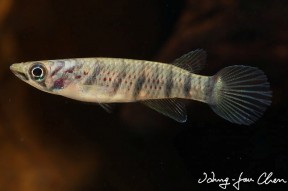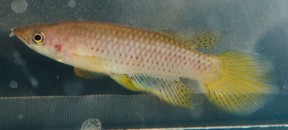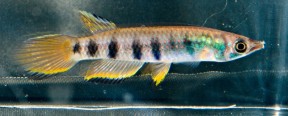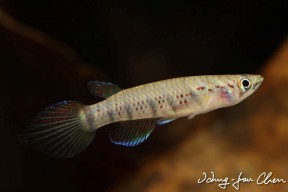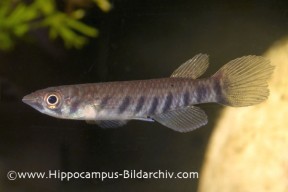Epiplatys sexfasciatus
Six-barred Panchax
SynonymsTop ↑
Haplochilus rubropunctatus Steindachner, 1867; Epiplatys sexfasciatus rathkei Radda, 1970; Epiplatys sexfasciatus togolensis Loiselle, 1971; Epiplatys sexfasciatus baroi Berkenkamp, 1975
Etymology
Epiplatys: from the Greek epi, meaning ‘above, on top of’, and platys, meaning ‘flat, broad’, in reference to the flat dorsal surface of the anterior half of the body in members of this genus.
sexfasciatus: from the Latin sex-, a prefix meaning ‘six’, and fasciatus, meaning ‘banded’.
Classification
Order: Cyprinodontiformes Family: Nothobranchiidae
Distribution
Distributed throughout coastal regions north and westwards from Gabon through Equatorial Guinea, Cameroon, Nigeria, Benin and Togo as far as Ghana although some consider it restricted to northwestern Gabon and Equatorial Guinea with the remaining populations representing various subspecies (see ‘Notes’).
Type locality is ‘Gaboon River’, which presumably refers to one or more of the rivers entering what is now referred to as the Gabon Estuary in Gabon, western Africa.
When the collection locality is known aquarists tend to label the fish as such in order to avoid hybridisation and preserve bloodlines, e.g., Benin City, Bidou, Cap Estérias, Coco Beach, Elon, Ibadan, Kinguélé, Lambaréné, Ntoum, Djigbé, Cotonou, etc.
Habitat
This species mostly inhabits freshwater swamps and minor tributary streams but unsurprisingly given the extent of its range habitats vary considerably with some populations inhabiting grassy savannah and others rainforest.
In some cases it’s also been observed in quieter, weedy zones of larger rivers and lakes.
Maximum Standard Length
60 – 70 mm.
Aquarium SizeTop ↑
Minimum base dimensions of 80 ∗ 30 cm or equivalent are recommended although smaller aquaria can be used for breeding purposes.
Maintenance
Perhaps looks best in a heavily-planted set-up or natural-style arrangement comprising a sandy substrate plus some driftwood roots and branches.
The addition of dried leaf litter would further emphasise the natural feel and as well as offering additional cover for the fish brings with it the growth of microbe colonies as decomposition occurs.
These can provide a valuable secondary food source for fry and the humic substances released by the decaying leaves are also considered beneficial, with alder cones also useful in this respect.
There’s no need to use natural peat, the collection of which is both unsustainable and environmentally-destructive.
This species seems to do best under fairly dim lighting but you can add aquatic plant species that can survive under such conditions such as Microsorum, Taxiphyllum or Anubias spp., while floating vegetation, such as Ceratopteris spp., is also appreciated.
Water Conditions
Temperature: 20 – 27 °C
pH: 5.0 – 7.0
Hardness: 18 – 215 ppm
Diet
Probably a predator feeding on terrestrial and aquatic invertebrates and other zooplankton in nature.
In the aquarium it will accept dried foods of a suitable size but should also be offered daily meals of small live and frozen fare such as Artemia nauplii, Daphnia, Moina, grindal worm, etc.
Small insects such as crickets or Drosophila fruit flies are also suitable to use although it’s best to fill the stomachs of these by feeding them fish flakes or some kind of vegetable matter before offering them to the fish.
Behaviour and CompatibilityTop ↑
Peaceful with other species and can make an excellent resident of the well-chosen community.
Many similarly-sized characids, cyprinids, anabantoids, callicthyids, loricariids are compatible and since it spends much of its time in the upper part of the water column certain cichlids are suitable as well.
Try to buy 6 or more specimens since it’s relatively gregarious and the fish will not only be less shy but display more interesting behaviour when maintained in larger groups.
Sexual Dimorphism
Males are more colourful, possess more-extended fins and grow larger than females.
Reproduction
Relatively easy to breed and in a well-decorated, mature species set-up fry may begin to appear without further intervention.
If the adults are being maintained in a community tank, however, it’s best to organise a separate aquarium for breeding purposes.
This can be very simple provided it contains a suitable medium for the fish to deposit their eggs in with Riccia, Taxiphylum spp. mosses, the roots of floating plants or woollen spawning mops all equally suitable, and if filtration is desired a small air-driven sponge-type unit is best.
Most breeders use a pair or single male plus two or more females with some preferring to remove and replace the medium every few days, incubating and hatching the eggs elsewhere, while others simply leave everything in situ until free-swimming fry can be seen near the water surface.
Adults do predate eggs and fry so if the intention is to raise good numbers it’s wise to separate them.
Incubation is around 12-14 days and provided the plants used are mature the fry are usually able to survive on the microorganisms which are present naturally, and a dried leaf or two can be added which will also promote the growth of such animals.
If raising the fry in more sterile conditions they initially require microscopic foods such as rotifers until large enough to accept Artemia nauplii and suchlike.
It’s important to omit larger invertebrates such as snails or shrimp from the breeding tank as they will consume eggs.
NotesTop ↑
This species is well-established in the aquarium hobby with several forms available.
Following the key of Romand (1992) it can be told apart from congeners by the following combination of characters: large, dark, transverse bars on flanks; longitudinal bands more-or-less defined; adult size > 50 mm SL; longitudinal bands composed of small red spots; caudal-fin sublanceolate; 15-19 anal-fin rays; 9-13 dorsal-fin rays; 7-8 anal-fin rays located anterior to dorsal-fin origin.
Its taxonomy is somewhat confusing with several subspecies, namely E. sexfasciatus baroi, E. s. leonensis, E. s. rathkei and E. s. togolensis having been described and the nominate form referred to as E. s. sexfasciatus in the past.
Among these E. s. leonensis is currently considered a synonym of E. fasciolatus while the remainder are synonymous with E. sexfasciatus, although E. s. togolensis in particular is considered valid by some authors and often referred to simply as E. togolensis.
E. infrafasciatus and E. multifasciatus have also been considered synonyms of E. sexfasciatus in the past but are currently valid, while confusingly both E. s. baroi and E. s. rathkei were previously thought to be synonymous with E. infrafasciatus rather than E. sexfasciatus.
We think it useful to provide some basic information about those subspecies still associated with E. sexfasciatus here since they’re often referred to separately in aquarium literature.
E. s. sexfasciatus is native to northwestern Gabon and southeastern Equatorial Guinea and can be identified from the other subspecies by the presence of extended median rays in the caudal-fin. Body colour is typically grey to reddish and there are normally 6 dark bars on the body.
E. s. baroi was described from ‘Creek 2.4 kilometers from “Palm Beach Hotel/Kribi” in direction to Kribi airfield, 2°58’N, 9°52’E, southern Cameroon’. It has a reddish-brown body, often yellow and/or red submarginal bands in the unpaired fins and usually six dark bars on the body.
E. s. rathkei was described from ‘Kumba water in the area of Kumba, 4°39’N, 9°26’E, western Cameroon’, which refers to a small river named ‘Kake’ near Lake Barombi Mbo (aka Barombi-ma-Mbu). The body is bluish with red-edged scales and 8-11 dark bars while the fins are yellowish with dark margins.
E. s. togolensis but has a relatively wide distribution extending eastwards from the Togo Hills in southeastern Ghana and southwestern Togo through southern Benin and southern Nigeria, including the Niger River delta, to the Cross River in southeastern Nigeria with type locality ‘Headwaters of Hedjo (Todzie) River in coffee plantation of the Chief of Eyo, 8 kilometers north of Palimé, 6°55’N, 0°37’E, Togo’. Its colour pattern varies somewhat depending on population but it most commonly has 6-8 dark bars and 4-7 lateral rows of reddish-brown spots on a yellowish body.
Epiplatys is the most widely-distributed genus of West African aplocheiloid killifish with a range overlapping that of the other genera native to the region which are more restricted and split into eastern and western groups based on their respective patterns of distribution.
For example, Callopanchax is restricted to coastal lowlands of far Western Africa with Scriptaphyosemion and Archiaphyosemion known only from the interior of the Western rainforest, whereas Aphyosemion and Fundulopanchax present more easterly ranges extending south and eastward from Nigeria.
Although previously considered closely-related to the genus Aplocheilus due to shared similarities such as possessing an upturned mouth and dwelling mostly near the water surface Epiplatys is in fact affiliated with the western group above, i.e., its closest relatives are Callopanchax, Scriptaphyosemion and Archiaphyosemion.
In addition the phylogenetic analysis of Collier et al. (2009) revealed the existence of two distinct clades within Epiplatys itself, one comprising those species restricted to the Western rainforest (the western/savanna clade) and other those inhabiting lowland (coastal) swamps and streams west of the Dahomey Gap.
Most members of the coastal clade have a colour pattern consisting of broad, dark vertical bars which are present in juveniles of those species which lack them as adults, plus many populations possess an asymmetric caudal-fin shape with an extended lower lobe, whereas western clade species tend to lack or only possess thin oblique dark bars on the body and have symmetrically-shaped caudal fins.
References
- Gill, T. N., 1862 - Proceedings of the Academy of Natural Sciences of Philadelphia v. 14: 134-139
On the West African genus Hemichromis and descriptions of new species in the museums of the Academy and Smithsonian Institution. - Aarn, A. and M. A. Shepherd, 2001 - Cybium 25(3): 209-225
Descriptive anatomy of Epiplatys sexfasciatus (Cyprinodontiformes: Aplocheilidae) and a phylogenetic analysis of Epiplatina. - Collier, G. E., W. J. Murphy and M. Espinoza, 2009 - Molecular Phylogenetics and Evolution 50(1): 190-196
Phylogeography of the genus Epiplatys (Aplocheiloidea: Cyprinodontiformes). - Hertwig, S. T., 2008 - Zoologica Scripta 37(2): 141-174
Phylogeny of the Cyprinodontiformes (Teleostei, Atherinomorpha): the contribution of cranial soft tissue characters. - Huber, J. H., 1998 - Journal of the American Killifish Association 31(3): 3-17
Miscellaneous notes on some systematic difficulties regarding Old World cyprinodonts. - Paugy, D. and V. Bénech, 1989 - Revue d'Hydrobiologie Tropicale 22(4): 295-316
Les poissons d'eau douce des bassins côtiers du Togo (Afrique de l'Ouest). - Paugy, D., C. Lévêque and G. G. Teugels, 2004 - RD Éditions, Publication scientifiques du Muséum, MRAC: 1-816
The Fresh and Brackish Water Fishes of West Africa Volume 2. - Romand, R. Cyprinodontidae. In: Lévêque, C., D. Paugy and G. G. Teugels (eds) , 1992 - Musée Royal de l'Afrique Centrale, Tervuren, Belgique and O.R.S.T.O.M., Paris, France: 389-902
Faune des poissons d'eaux douces et saumâtres de l'Afrique de l'Ouest Tome 2. Collection Fauna Tropicale no. XXVIII. - Trewavas, E., 1974 - Bulletin of the British Museum (Natural History), Zoology v. 26: 331-419
The freshwater fishes of rivers Mungo and Meme and Lakes Kotto, Mboandong and Soden, west Cameroon.


